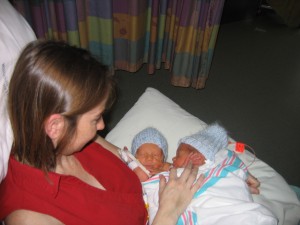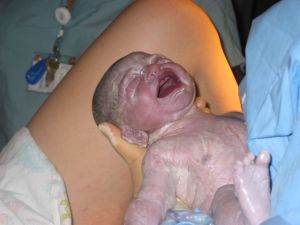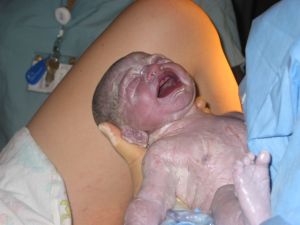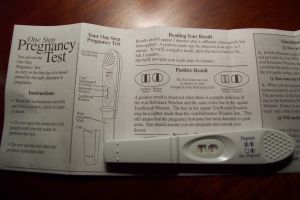By Amy McGovern, co-leader of API of Norman, Oklahoma

I woke up on a Sunday wondering, again, if this was the day my husband, Andy, and I would get to meet William. After church, I tried to rest but kept waking up with repeated mild cramps. A phone call to my mom confirmed the start of labor. Contractions were ten minutes apart. Excited, we took the dog for a walk to speed labor along, but we had to stop because the contractions began to hurt. We tried to play a board game as a distraction, but I had a lot of trouble concentrating because the contractions were really hurting now. I was completely unprepared for how much they would hurt given how mild they had been earlier! And everyone I knew had very mild labors, so I did not expect it.
By the time the contractions were five minutes apart, I was convinced he was coming any minute! I quickly ate, and we dropped off the dog at our neighbors. As we drove to the hospital 45 minutes away, I called both our parents to tell them what was happening. The contractions hurt so much that I still thought William would arrive in the car, but both moms said I was talking too much for that to happen.
When we arrived at the hospital, they said I was only at two centimeters dilated. They were about to send me home but I vomited. The nurse told me that I was not very far along, and she was not convinced labor would keep going on its own. She sent us off to walk for an hour and then come back for a re-check. We started to make laps, but the area was small and we quickly got bored. We pulled out our board game, and Andy made me walk laps after every turn. We played until I was gasping from the contractions coming every three to four minutes. All that pain had to be worth at least a few centimeters, but I had only dilated one more centimeter. It was about midnight and they were preparing to send us home about midnight, when the heart monitor showed a sudden drop and I was quickly admitted. They offered me some pain medication, and the nurse told me that it would help me to dilate if I could relax. I slept for only a few hours.
Monday
Twenty-one hours into labor, the Monday morning obstetrician said I was only at four centimeters, so she broke my water. I asked for an epidural, because the contractions hurt far more than I had anticipated. I demanded that my epidural be a “walking one” without really knowing what that meant. First, they broke my water and the obstetrician said, “Oh, my favorite color.” I asked what she meant, and she said it was meconium.
When the anesthesiologist gave me the epidural, I started to relax. Then, all of a sudden, the room was filled with doctors and nurses! I was a bit loopy from the medicine and did not know what was wrong. The nurse and the obstetrician kept repositioning me, and I finally ended up on my knees before they were happy. It turned out that the epidural made William’s heart rate drop. Once he was back to normal, I was allowed up but was monitored wirelessly.
Determined to get William here quickly, we went for a walk by the nursery, which helped motivate me for the upcoming pushing. I knew it would be hard, and I wanted to see all those newborns whose moms had succeeded. We walked for a long time and stopped for a grape popsicle in the afternoon. Worn out, I walked back to my room to eat stopping once to leak water all over the floor. Apparently, William shifted!
After some rest and another exam that showed I was at seven centimeters, I tried to get up to go to the bathroom. No one had told me that if you lie down, the epidural would go to your legs. I started to fall as I tried to get out of bed but the nurses and Andy caught me. Frustrated, I ended up in bed waiting for ten centimeters. Sometime in this time period, a nurse came in and gasped, “She’s cyanotic! She has asthma, aren’t you worried?” The other nurse just laughed and said, “No, that’s the grape popsicles!”
Finally, around 8:30 p.m., the obstetrician on-call came in, examined me, and told me that I was at ten centimeters. I was at last allowed to push! However, I didn’t feel any urge to push, so they put me on Pitocin. I was too exhausted to really argue. All I knew is that I wanted William to get here soon.
The doctor left me with two labor nurses and Andy. I tried to push when they told me. One of them helped me to stand up, and I tried to use the squatting bar. The nurse got very excited when she could see William’s hair. I was pushing as hard as I could but no other progress happened. I kept thinking, “If I push hard, his birthday will be today!”
After about an hour and a half of pushing, the doctor came back, watched me push, and said, “You are not pushing right,” and left. I wanted to shout at him, “How many babies have you pushed out? I’m doing the best I can!” but he was already gone. Besides, I was really too tired to do anything else.
After three hours of pushing with no further progress, the nurses called the doctor back in and he examined me again. He told me that I had to have a Caesarean section. By this time, it was 11:30 p.m. I was so exhausted that I barely had any energy to move, but I argued with him that there had to be another way. We finally agreed together that William needed to get here soon, for his sake and mine. As we made the decision, the doctor turned off the Pitocin drip, and the contractions immediately stopped.
Tuesday
Around midnight, as the night dissolved into Tuesday, the nurses wheeled me in the OR. I told the nurses that Andy did not like the sight of blood so they whisked him away while they prepped me. However, I was terrified and began to shake uncontrollably, but the kind nurses held my hand and told me it was just hormones. I joked that the extra anesthesia didn’t work, because I could still wiggle my toes.
Andy finally was allowed in when surgery started. I felt a lot of pulling and tugging, and the nurse and anesthesiologist narrated for me. Finally, they pulled William out, but he didn’t cry. I kept asking, “Why isn’t he crying? Is he ok? What is wrong?” They kept reassuring me that he was fine and he was being cleaned out. The Neonatal Intensive Care Unit (NICU) team was there, and I suddenly heard a loud wail. I was so relieved! Shortly after that, the NICU team announced, “We are all set! Congratulations!” and they left.
The doctor told Andy that William had been turned 90 degrees and had gotten stuck. Looking back now, I wonder if the reason labor hurt so much was that it was back labor? Apparently this was the doctor’s way of apologizing for telling me that I wasn’t pushing right: by telling me it wasn’t my fault.
The nurses finally held William up for me to see, since I was still being sewed up, and asked me to name him. I was so exhausted and relieved that I started to cry. Andy told them proudly, “William Robin.”
Around 2 a.m., I was wheeled into the very cold recovery room. We called our parents, and my mom tried to talk my dad into coming right then but he told her that he needed to sleep before driving for eight hours. She stayed up the rest of the night researching Caesarean sections, and he drove them up later that morning.
Around 3 a.m., a nurse appeared and said, “It says on your chart you are breastfeeding. Is that right?” She came back with William and said, “Ok, here you go! Twenty minutes on each side!” I had no idea what to do, so she helped to get him latched on and she left. I sleepily watched him for 20 minutes, and she came back to make sure I switched sides. Afterwards, they took him to the nursery. Around 4 a.m., they unhooked me and wheeled me upstairs. Exhausted from labor and surgery, I feel asleep quickly.
Around 7 or 8 a.m., I woke up with a start and demanded my baby now! Andy brought him in, and I finally got to examine him carefully from head to toe. He was wonderful – our sweet William Robin!

 A University of Maryland study shows that, more than marriage, involving the father during the prenatal period leads to a stable family life.
A University of Maryland study shows that, more than marriage, involving the father during the prenatal period leads to a stable family life. Despite best evidence, health care providers continue to perform routine procedures during labor and birth that often are unnecessary and can have harmful results for mothers and babies.
Despite best evidence, health care providers continue to perform routine procedures during labor and birth that often are unnecessary and can have harmful results for mothers and babies.

